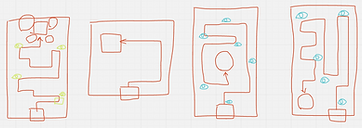MICRO SAVIOR
Project Introduction
Micro Savior is a third-person puzzle adventure game set in a microscopic electronic world. The player controls a small maintenance robot, exploring an infected chip system, shutting down key power switches, cleverly using objects to avoid laser traps, and finally destroying the corrupted core chip to save the whole circuit board.
Click to see the playable page
Inspiration & Concept
The inspiration for this game mainly comes from my fascination with the micro world and my childhood memories of taking apart electronics. In my eyes, a circuit board looks like a city map, so I wanted to create a “chip maze” adventure. I hope players will feel both mystery and tension while exploring, as if they’re in an unknown but dangerous tiny universe.
Gameplay & Design
The core mechanics were simple at first—press the buttons and destroy the chip. As I developed the idea, I kept asking: what challenges would the player face before pressing each button? This led to adding defense towers and laser traps. Then I wondered: how could the player avoid lasers? I came up with the idea of grabbing objects to block the beams. To make this more interesting, players can rotate the grabbed objects with the mouse wheel to shield themselves from lasers in any direction, and in special places, turn objects into bridges to cross gaps.


Gameplay ideas
For level design, I followed the principle of going from easy to difficult. The first level is a linear maze with increasing towers and laser density. To prevent players from getting lost, I placed landmarks—like the corrupted chip’s location—so players always know where they are and can estimate the level’s length. Each button acts as a new checkpoint, so dying doesn’t send the player back to the very start, making the experience less frustrating.


Some level ideas











Level Sketches
Art & Atmosphere
For the visual style, I chose low-poly modeling to keep the scene clean and optimized. The red tentacles represent pollution and also add a touch of Cthulhu-like mystery. I used fog effects to make the scene more mysterious and oppressive.





Art & structure of circuit board research
Click to see the playable page




Level Design


Robot Design





Technical Implementation & Challenges
On the programming side, updating spawn points and building bridges from grabbed objects were the most complex parts. I had to write scripts to reset the position of all grabbable objects after death, to avoid glitches. Different systems—like grabbing, laser detection, respawn, and UI—are all coordinated through events and singletons.


Reflection & Future Plans
My biggest gain was learning how to turn a concept into a complete interactive experience, and how to polish the user experience through constant iteration. I think the scene’s atmosphere could be even better. In the future, I want to use higher-quality models, maybe even try a VR version. I also plan to add an ending cutscene and create new levels with features like patrolling viruses and dynamic terrain, to make the game more challenging and fun.
Click to see the playable page



